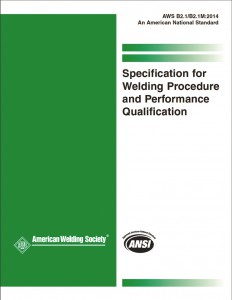Understand the Building Blocks for a Quality Welding Program
A methodical evaluation of the job requirements and welder skills is presented to help new welding engineers develop sustainable programs. By Lee G. Kvidahl, manager, Welding Engineering, Ingalls Shipbuilding, Pascagoula, Miss., and an AWS past president. Reprinted with permission: The Welding Journal A welding program that demonstrates consistent quality performance begins with very basic tools. An understanding of the requirements to produce an acceptable product is communicated, in writing, to the welder who has previously demonstrated sufficient skill and ability by producing workmanship samples tested as required by the customer’s specification. From these building blocks, a program that consistently produces quality welded products can succeed in the modern world economy. The Welding Engineer’s Job A major responsibility for most welding engineers is to develop and create the welding procedure specifications (WPSs). These written instructions provide the technical direction for a welding operation. The WPS is typically based upon objective qualification test data and contains the process essential elements to provide the welder or welding operator the technical information required to complete a weld. There are no industry standards for the format or content of a WPS. There is a wide variety of standards and codes (Fig. 1) that suggest a format to be used, but the format is not the most important feature of a WPS. The technical content is the most critical component. Working with the Standards There are many industry standards and codes that do define the information to be provided in each WPS. In many cases, these standards and codes provide very similar directions but not necessarily identical directions. For this reason, it is imperative that each welding engineer research the specific requirements for each of the standards or codes invoked by the customer receiving the welded product. This cannot be stressed enough — the WPS must incorporate all of the information defined by the applicable contractual fabrication standard and not have been based upon an assumption that one WPS may be adequate for multiple standards. Essential Elements of the WPS The core of any WPS is the essential elements. Commonly, a fabrication standard will define what comprises the WPS essential elements and what information is mandatory for inclusion in the procedure. The elements themselves may change based upon the process definition, such as additional elements are required for an automatic process than a manual welding process. Based upon the product being welded and the fabrication standard, the number and specifics of what WPS information is defined as essential will determine the content of the welding procedure. Following are some of the more common essential elements contained in welding procedures.- Process — Every WPS requires the type of welding process and additionally whether it is to be used semiautomatically, automatically, or in conjunction with some type of machine.
- Base Material — Each specification may require this information to be reported in a different manner. Many standards group the potential base materials into families based upon chemistry or mechanical properties. A WPS may simply reference the correct family of materials, as defined by the fabrication standard, or may need to include the applicable material specification and more specific material designations.
- Base Material Thickness — A WPS may be restricted to a material thickness range. Normally, this is based upon the material thickness used for qualification testing, i.e., the procedure qualification record (PQR).
- Filler Material — Similar to the base materials, many of the filler materials are grouped together based upon chemistry. While this may simplify a requirement, it is important that the WPS specify the type of filler material to be used for the intended application. For example, it is common for all of the austenitic stainless steel filler materials to be placed into a single group, but the WPS must direct the welder to use the correct alloy for the specific type of base material and the service condition the welded component will experience.
- Joint Design — The WPS may be restricted to a family or families of joint designs. If the supporting PQR utilized a partial penetration joint design, most likely the WPS may not be applicable for applications requiring a complete-joint-penetration weld. In the case of fully automatic welding procedures, rather than a family of joint designs, the WPS may require a very specific machined weld preparation.
- Electrical Characteristics — For arc welding procedures, amperage, voltage, and polarity are almost universally required as essential elements. Some standards may accept a wire feed speed range to replace the amperage range in the WPS.
- Gases — If a gas is used for the welding process, a definition of the type and potential mixes of gases, the minimum flow rate, and whether the procedure requires just a shielding gas in the immediate zone of the arc or if additional shielding gas is required for internal purging or as a trailing shield will be required. It is also common for the WPS to provide direction as to the minimum size of the shielding gas cup to be used.
- Heating Requirements — Certain materials require a minimum preheat or maximum interpass temperature to be incorporated into the welding operation. The WPS will contain this information as well as any postwelding heating operations such as a low-temperature soaking heat or a full-bore stress relief.
- Procedural Requirements — Other procedural elements may be required to complete the WPS. Factors such as travel speed, torch orientation, preweld cleanliness, and other attributes may be required by the specifications or codes being employed for the specific job. It is mandatory that the author of the WPS review the specification requirements thoroughly to ensure that the necessary information is contained in the WPS.
















